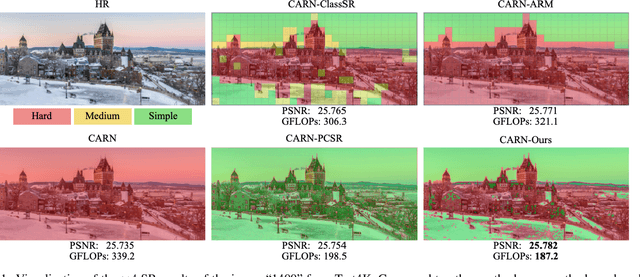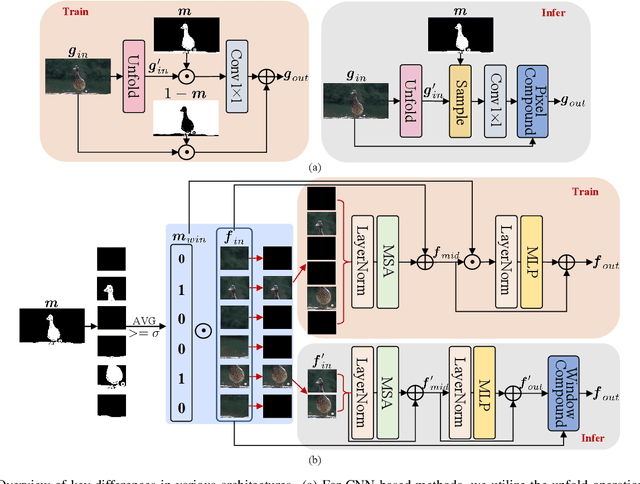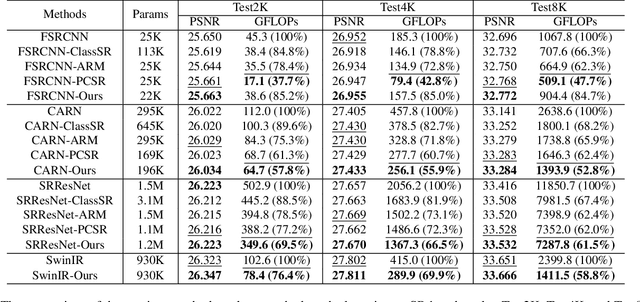Qinghua Hu
BasicAVSR: Arbitrary-Scale Video Super-Resolution via Image Priors and Enhanced Motion Compensation
Oct 30, 2025Abstract:Arbitrary-scale video super-resolution (AVSR) aims to enhance the resolution of video frames, potentially at various scaling factors, which presents several challenges regarding spatial detail reproduction, temporal consistency, and computational complexity. In this paper, we propose a strong baseline BasicAVSR for AVSR by integrating four key components: 1) adaptive multi-scale frequency priors generated from image Laplacian pyramids, 2) a flow-guided propagation unit to aggregate spatiotemporal information from adjacent frames, 3) a second-order motion compensation unit for more accurate spatial alignment of adjacent frames, and 4) a hyper-upsampling unit to generate scale-aware and content-independent upsampling kernels. To meet diverse application demands, we instantiate three propagation variants: (i) a unidirectional RNN unit for strictly online inference, (ii) a unidirectional RNN unit empowered with a limited lookahead that tolerates a small output delay, and (iii) a bidirectional RNN unit designed for offline tasks where computational resources are less constrained. Experimental results demonstrate the effectiveness and adaptability of our model across these different scenarios. Through extensive experiments, we show that BasicAVSR significantly outperforms existing methods in terms of super-resolution quality, generalization ability, and inference speed. Our work not only advances the state-of-the-art in AVSR but also extends its core components to multiple frameworks for diverse scenarios. The code is available at https://github.com/shangwei5/BasicAVSR.
Constrained Prompt Enhancement for Improving Zero-Shot Generalization of Vision-Language Models
Aug 24, 2025Abstract:Vision-language models (VLMs) pre-trained on web-scale data exhibit promising zero-shot generalization but often suffer from semantic misalignment due to domain gaps between pre-training and downstream tasks. Existing approaches primarily focus on text prompting with class-specific descriptions and visual-text adaptation via aligning cropped image regions with textual descriptions. However, they still face the issues of incomplete textual prompts and noisy visual prompts. In this paper, we propose a novel constrained prompt enhancement (CPE) method to improve visual-textual alignment by constructing comprehensive textual prompts and compact visual prompts from the semantic perspective. Specifically, our approach consists of two key components: Topology-Guided Synonymous Semantic Generation (TGSSG) and Category-Agnostic Discriminative Region Selection (CADRS). Textually, to address the issue of incomplete semantic expression in textual prompts, our TGSSG first generates synonymous semantic set for each category via large language models, and constructs comprehensive textual prompts based on semantic ambiguity entropy and persistent homology analysis. Visually, to mitigate the irrelevant visual noise introduced by random cropping, our CADRS identifies discriminative regions with activation maps outputted by a pre-trained vision model, effectively filtering out noisy regions and generating compact visual prompts. Given the comprehensive set of textual prompts and compact set of visual prompts, we introduce two set-to-set matching strategies based on test-time adaptation (TTA) and optimal transport (OT) to achieve effective visual-textual alignment, and so improve zero-shot generalization of VLMs.
Semantic Energy: Detecting LLM Hallucination Beyond Entropy
Aug 20, 2025Abstract:Large Language Models (LLMs) are being increasingly deployed in real-world applications, but they remain susceptible to hallucinations, which produce fluent yet incorrect responses and lead to erroneous decision-making. Uncertainty estimation is a feasible approach to detect such hallucinations. For example, semantic entropy estimates uncertainty by considering the semantic diversity across multiple sampled responses, thus identifying hallucinations. However, semantic entropy relies on post-softmax probabilities and fails to capture the model's inherent uncertainty, causing it to be ineffective in certain scenarios. To address this issue, we introduce Semantic Energy, a novel uncertainty estimation framework that leverages the inherent confidence of LLMs by operating directly on logits of penultimate layer. By combining semantic clustering with a Boltzmann-inspired energy distribution, our method better captures uncertainty in cases where semantic entropy fails. Experiments across multiple benchmarks show that Semantic Energy significantly improves hallucination detection and uncertainty estimation, offering more reliable signals for downstream applications such as hallucination detection.
Adapting LLMs to Time Series Forecasting via Temporal Heterogeneity Modeling and Semantic Alignment
Aug 10, 2025Abstract:Large Language Models (LLMs) have recently demonstrated impressive capabilities in natural language processing due to their strong generalization and sequence modeling capabilities. However, their direct application to time series forecasting remains challenging due to two fundamental issues: the inherent heterogeneity of temporal patterns and the modality gap between continuous numerical signals and discrete language representations. In this work, we propose TALON, a unified framework that enhances LLM-based forecasting by modeling temporal heterogeneity and enforcing semantic alignment. Specifically, we design a Heterogeneous Temporal Encoder that partitions multivariate time series into structurally coherent segments, enabling localized expert modeling across diverse temporal patterns. To bridge the modality gap, we introduce a Semantic Alignment Module that aligns temporal features with LLM-compatible representations, enabling effective integration of time series into language-based models while eliminating the need for handcrafted prompts during inference. Extensive experiments on seven real-world benchmarks demonstrate that TALON achieves superior performance across all datasets, with average MSE improvements of up to 11\% over recent state-of-the-art methods. These results underscore the effectiveness of incorporating both pattern-aware and semantic-aware designs when adapting LLMs for time series forecasting. The code is available at: https://github.com/syrGitHub/TALON.
Motion-Aware Adaptive Pixel Pruning for Efficient Local Motion Deblurring
Jul 10, 2025Abstract:Local motion blur in digital images originates from the relative motion between dynamic objects and static imaging systems during exposure. Existing deblurring methods face significant challenges in addressing this problem due to their inefficient allocation of computational resources and inadequate handling of spatially varying blur patterns. To overcome these limitations, we first propose a trainable mask predictor that identifies blurred regions in the image. During training, we employ blur masks to exclude sharp regions. For inference optimization, we implement structural reparameterization by converting $3\times 3$ convolutions to computationally efficient $1\times 1$ convolutions, enabling pixel-level pruning of sharp areas to reduce computation. Second, we develop an intra-frame motion analyzer that translates relative pixel displacements into motion trajectories, establishing adaptive guidance for region-specific blur restoration. Our method is trained end-to-end using a combination of reconstruction loss, reblur loss, and mask loss guided by annotated blur masks. Extensive experiments demonstrate superior performance over state-of-the-art methods on both local and global blur datasets while reducing FLOPs by 49\% compared to SOTA models (e.g., LMD-ViT). The source code is available at https://github.com/shangwei5/M2AENet.
Bi-directional Self-Registration for Misaligned Infrared-Visible Image Fusion
May 11, 2025Abstract:Acquiring accurately aligned multi-modal image pairs is fundamental for achieving high-quality multi-modal image fusion. To address the lack of ground truth in current multi-modal image registration and fusion methods, we propose a novel self-supervised \textbf{B}i-directional \textbf{S}elf-\textbf{R}egistration framework (\textbf{B-SR}). Specifically, B-SR utilizes a proxy data generator (PDG) and an inverse proxy data generator (IPDG) to achieve self-supervised global-local registration. Visible-infrared image pairs with spatially misaligned differences are aligned to obtain global differences through the registration module. The same image pairs are processed by PDG, such as cropping, flipping, stitching, etc., and then aligned to obtain local differences. IPDG converts the obtained local differences into pseudo-global differences, which are used to perform global-local difference consistency with the global differences. Furthermore, aiming at eliminating the effect of modal gaps on the registration module, we design a neighborhood dynamic alignment loss to achieve cross-modal image edge alignment. Extensive experiments on misaligned multi-modal images demonstrate the effectiveness of the proposed method in multi-modal image alignment and fusion against the competing methods. Our code will be publicly available.
High-Frequency Prior-Driven Adaptive Masking for Accelerating Image Super-Resolution
May 11, 2025



Abstract:The primary challenge in accelerating image super-resolution lies in reducing computation while maintaining performance and adaptability. Motivated by the observation that high-frequency regions (e.g., edges and textures) are most critical for reconstruction, we propose a training-free adaptive masking module for acceleration that dynamically focuses computation on these challenging areas. Specifically, our method first extracts high-frequency components via Gaussian blur subtraction and adaptively generates binary masks using K-means clustering to identify regions requiring intensive processing. Our method can be easily integrated with both CNNs and Transformers. For CNN-based architectures, we replace standard $3 \times 3$ convolutions with an unfold operation followed by $1 \times 1$ convolutions, enabling pixel-wise sparse computation guided by the mask. For Transformer-based models, we partition the mask into non-overlapping windows and selectively process tokens based on their average values. During inference, unnecessary pixels or windows are pruned, significantly reducing computation. Moreover, our method supports dilation-based mask adjustment to control the processing scope without retraining, and is robust to unseen degradations (e.g., noise, compression). Extensive experiments on benchmarks demonstrate that our method reduces FLOPs by 24--43% for state-of-the-art models (e.g., CARN, SwinIR) while achieving comparable or better quantitative metrics. The source code is available at https://github.com/shangwei5/AMSR
DALIP: Distribution Alignment-based Language-Image Pre-Training for Domain-Specific Data
Apr 02, 2025Abstract:Recently, Contrastive Language-Image Pre-training (CLIP) has shown promising performance in domain-specific data (e.g., biology), and has attracted increasing research attention. Existing works generally focus on collecting extensive domain-specific data and directly tuning the original CLIP models. Intuitively, such a paradigm takes no full consideration of the characteristics lying in domain-specific data (e.g., fine-grained nature of biological data) and so limits model capability, while mostly losing the original ability of CLIP in the general domain. In this paper, we propose a Distribution Alignment-based Language-Image Pre-Training (DALIP) method for biological data. Specifically, DALIP optimizes CLIP models by matching the similarity between feature distribution of image-text pairs instead of the original [cls] token, which can capture rich yet effective information inherent in image-text pairs as powerful representations, and so better cope with fine-grained nature of biological data. Particularly, our DALIP efficiently approximates feature distribution via its first- and second-order statistics, while presenting a Multi-head Brownian Distance Covariance (MBDC) module to acquire second-order statistics of token features efficiently. Furthermore, we collect a new dataset for plant domain (e.g., specific data in biological domain) comprising 10M plant data with 3M general-domain data (namely PlantMix-13M) according to data mixing laws. Extensive experiments show that DALIP clearly outperforms existing CLIP counterparts in biological domain, while well generalizing to remote sensing and medical imaging domains. Besides, our PlantMix-13M dataset further boosts performance of DALIP in plant domain, while preserving model ability in general domain.
Dig2DIG: Dig into Diffusion Information Gains for Image Fusion
Mar 24, 2025Abstract:Image fusion integrates complementary information from multi-source images to generate more informative results. Recently, the diffusion model, which demonstrates unprecedented generative potential, has been explored in image fusion. However, these approaches typically incorporate predefined multimodal guidance into diffusion, failing to capture the dynamically changing significance of each modality, while lacking theoretical guarantees. To address this issue, we reveal a significant spatio-temporal imbalance in image denoising; specifically, the diffusion model produces dynamic information gains in different image regions with denoising steps. Based on this observation, we Dig into the Diffusion Information Gains (Dig2DIG) and theoretically derive a diffusion-based dynamic image fusion framework that provably reduces the upper bound of the generalization error. Accordingly, we introduce diffusion information gains (DIG) to quantify the information contribution of each modality at different denoising steps, thereby providing dynamic guidance during the fusion process. Extensive experiments on multiple fusion scenarios confirm that our method outperforms existing diffusion-based approaches in terms of both fusion quality and inference efficiency.
CoE: Chain-of-Explanation via Automatic Visual Concept Circuit Description and Polysemanticity Quantification
Mar 19, 2025Abstract:Explainability is a critical factor influencing the wide deployment of deep vision models (DVMs). Concept-based post-hoc explanation methods can provide both global and local insights into model decisions. However, current methods in this field face challenges in that they are inflexible to automatically construct accurate and sufficient linguistic explanations for global concepts and local circuits. Particularly, the intrinsic polysemanticity in semantic Visual Concepts (VCs) impedes the interpretability of concepts and DVMs, which is underestimated severely. In this paper, we propose a Chain-of-Explanation (CoE) approach to address these issues. Specifically, CoE automates the decoding and description of VCs to construct global concept explanation datasets. Further, to alleviate the effect of polysemanticity on model explainability, we design a concept polysemanticity disentanglement and filtering mechanism to distinguish the most contextually relevant concept atoms. Besides, a Concept Polysemanticity Entropy (CPE), as a measure of model interpretability, is formulated to quantify the degree of concept uncertainty. The modeling of deterministic concepts is upgraded to uncertain concept atom distributions. Finally, CoE automatically enables linguistic local explanations of the decision-making process of DVMs by tracing the concept circuit. GPT-4o and human-based experiments demonstrate the effectiveness of CPE and the superiority of CoE, achieving an average absolute improvement of 36% in terms of explainability scores.
 Add to Chrome
Add to Chrome Add to Firefox
Add to Firefox Add to Edge
Add to Edge